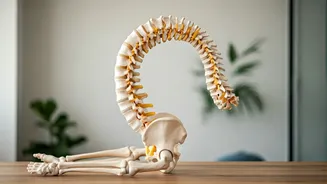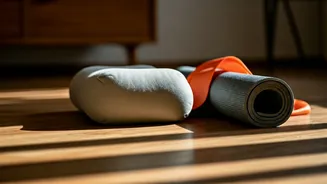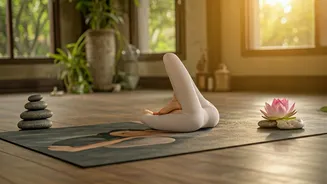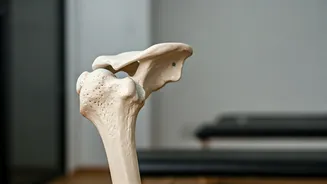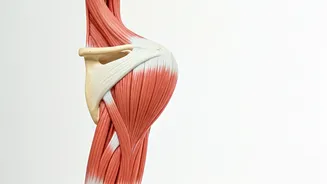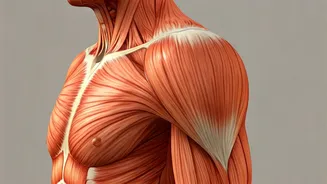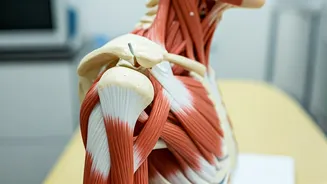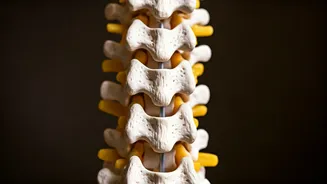Knee-to-Chest Stretch
The knee-to-chest stretch is an excellent starting point for tackling lower back pain. To execute this, lie on your back with your knees bent and feet
flat on the floor. Gently bring one knee towards your chest, clasping your hands around the shin or the back of your thigh. Hold this position for approximately 20-30 seconds, feeling a gentle stretch in your lower back. Release the leg slowly and repeat the process with the other leg. This stretch works wonders by loosening the muscles surrounding the spine, thereby decreasing pressure and easing pain. When performing this stretch, focus on keeping your lower back pressed against the floor, ensuring you are comfortable and preventing any undue strain. Remember to breathe deeply and evenly throughout the stretch, maximizing the relaxation and benefits. This exercise, when performed correctly, can be a great asset in your pain management strategy, offering quick and accessible relief.
Flexion-Rotation Stretch
Moving on to the flexion-rotation stretch, this exercise contributes to improved mobility and decreased pain. Begin by lying on your back with your knees bent and feet flat on the floor. Extend your arms out to the sides, forming a 'T' shape. Keeping your shoulders flat on the floor, slowly drop both knees to one side, twisting your lower back. Hold the position for about 20-30 seconds, and then return to the starting position. Repeat this motion, dropping your knees to the opposite side. This stretch targets the oblique muscles and the lower back, providing relief by increasing flexibility and reducing stiffness. By adding a gentle twist, this stretch promotes a healthy range of motion in the spine and alleviates the buildup of tension. When performing this exercise, make sure your shoulders stay in contact with the floor. This provides stability, making the stretch more effective and minimizing the risk of injury. Deep, controlled breaths throughout the exercise will enhance the relaxing effects.
Trunk Rotation Exercise
The trunk (spinal) rotation exercise is another effective technique to address lower back pain, promoting flexibility and reducing discomfort. Start by lying on your back with your knees bent and your feet planted firmly on the floor. Keep your arms extended to the sides. With your knees together, slowly rotate them to one side, keeping your shoulders firmly on the ground. Hold this position for about 20 to 30 seconds. Slowly return your knees to the center, and repeat the movement, rotating them to the opposite side. This stretch helps to mobilize the spine and reduce muscle tension by twisting the torso. Maintaining a steady pace while rotating helps to deepen the stretch without causing strain. This exercise also increases blood flow in the area, contributing to faster healing and pain reduction. Breathe deeply throughout the exercise, as this helps to deepen the stretch and increase relaxation. This is a highly beneficial stretch that can be integrated into your routine to boost spinal health.
Pelvic Tilt Technique
The pelvic tilt is a foundational exercise to stabilize and strengthen the core, and helps reduce back pain. Lie on your back with your knees bent and feet flat on the floor. Gently flatten your lower back against the floor by tilting your pelvis upward. Hold this position for a few seconds, then return to a neutral position. Next, arch your lower back slightly, feeling the space between your back and the floor. This creates an alternating rhythm of tightening and releasing muscles, which can reduce stiffness and improve posture. Do this for several repetitions. This exercise strengthens the abdominal muscles, which in turn support the spine, leading to decreased back pain. The pelvic tilt enhances core stability, crucial for minimizing strain on the lower back. Performing this exercise properly requires a conscious effort to isolate the movement of your pelvis, keeping the rest of your body relaxed. Regular practice improves posture and reduces strain. Adding this to your routine provides a powerful means to decrease lower back pain.
Cat-Cow Stretch
The Cat-Cow stretch is an excellent method for enhancing spinal mobility and alleviating lower back pain. Begin on your hands and knees, with your hands placed directly under your shoulders and your knees under your hips. For the 'cat' pose, round your spine toward the ceiling, tucking your chin to your chest and engaging your abdominal muscles. For the 'cow' pose, drop your belly towards the floor, arching your back, and lifting your head and tailbone towards the ceiling. Alternate between these two poses smoothly, flowing through each for 5-10 breaths. This dynamic stretch gently massages the spine, improving its flexibility and lessening discomfort. This practice helps to improve blood flow to the spinal region, which further aids in healing and easing stiffness. Maintaining a steady pace and focusing on the breath will help coordinate the movements, making them more effective. The Cat-Cow stretch also promotes good posture, which is essential for preventing future back pain. The rhythmic nature of this exercise makes it soothing, which helps to relax the body. This stretch is a great way to start or end the day to keep your spine healthy.
Supported Bridge Exercise
The supported bridge provides a gentle approach to stretching your lower back while also strengthening your core and glutes. To begin, lie on your back with your knees bent and feet flat on the floor, hip-width apart. Place a pillow or a rolled-up towel beneath your lower back to provide support. Gently lift your hips off the floor, engaging your glutes and core muscles. Hold this position for approximately 15-30 seconds, maintaining a straight line from your knees to your shoulders. Slowly lower your hips back down to the floor. Repeat this exercise several times. This exercise eases lower back pain by relieving pressure and improving flexibility. This exercise also activates and strengthens the supporting muscles of your back and hips, making the spine more stable. By using a pillow for support, this exercise allows you to perform the movements more safely and prevents any potential overstretching. Consistent practice of the supported bridge can significantly reduce back pain and improve your overall posture. Remember to breathe evenly to relax and get the most out of each repetition.
Seated Hamstring Stretch
This stretch is especially beneficial because tight hamstrings can often contribute to lower back pain. Start by sitting on the floor with your legs extended straight in front of you. Bend one knee and bring the sole of your foot to touch the inside of your opposite thigh. Keep your back straight, and slowly reach for your toes. You can also slightly bend your knee to reduce any strain. Hold this position for about 20 to 30 seconds. Repeat the stretch with the other leg. This stretch helps to lengthen your hamstring muscles, which reduces strain on your lower back. By regularly stretching your hamstrings, you improve your flexibility and promote proper posture. Make sure you avoid bouncing or forcing the stretch. Instead, focus on a slow, controlled movement. It's also important to maintain a straight back. The seated hamstring stretch provides a gentle, effective way to reduce the tension that leads to lower back pain. This exercise is simple to do, making it accessible to anyone with back pain.
Child’s Pose Exercise
The child’s pose is a relaxing and effective stretch that gently eases lower back pain and helps to de-stress. Start by kneeling on the floor with your big toes touching and your knees hip-width apart. Sit back on your heels. If this is uncomfortable, you can place a pillow between your heels and your buttocks. Then, slowly bend forward, resting your torso on your thighs and extending your arms forward or alongside your body. Your forehead should rest on the floor. Hold this position for 30 seconds to a few minutes, focusing on your breath. This pose gently stretches your lower back, hips, and thighs, which helps to relieve tension. Its calming effect also helps in relaxation. This pose is particularly beneficial for those experiencing back pain because it gently decompresses the spine. During this pose, concentrate on breathing deeply into your back, which will help to deepen the stretch and enhance relaxation. Make this stretch a part of your regular routine, and you’ll notice a significant improvement in your comfort level and flexibility.
